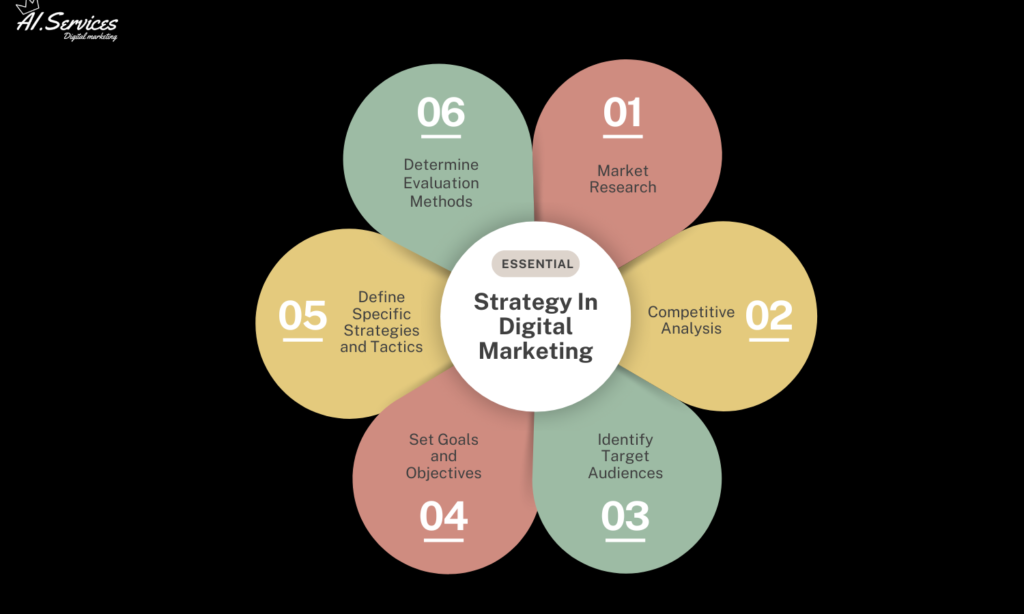
Crafting a winning social media strategy can be daunting amidst a sea of platforms and trends. This guide simplifies the process, equipping you to build a plan that targets your audience and achieves your business goals. Forget the overwhelm; let’s navigate the social media landscape together in this insightful article on How to do social media Marketing, a step-by-step guide in 2024

In essence, this article empowers you to Create a targeted and effective social media marketing plan.
Feeling lost in the social media jungle? This guide cuts through the chaos, helping you build a targeted strategy to reach your audience and achieve your brand’s goals. Learn what social media marketing is, define your target, set goals, choose platforms, craft content, grow your following, and measure success. Master social media with this step-by-step guide!
By the end of this article, you’ll have a clear understanding of how to create a social media marketing plan that aligns with your business objectives and resonates with your audience. For instance, if your goal is to boost sales by 20%, determine how social media can contribute to this objective through tactics like social selling or promoting customer loyalty programs. So, let’s dive in and get started!
Importance of Social Media Marketing
- Understand what social media marketing is and why it’s important for businesses.
- Develop a social media strategy that aligns with your business objectives and target audience.
- Create engaging content, grow your audience, and measure your success through analytics.
Understanding Your Audience and Competitors

Social media marketing is a digital marketing strategy that involves promoting your brand, product, or service on social media platforms such as Facebook, Instagram, Twitter, LinkedIn, and others. It is a way to connect with your audience, build brand awareness, and increase engagement.
Knowing who your audience is and where they spend their time online is crucial. Use social analytics and listening tools to gather insights about your potential customers and competitors. This information helps in tailoring your content strategy to meet the preferences of your target audience and to differentiate your brand from competitors.
Importance of Target Demographics in Business
Social media has become an integral part of digital marketing and has revolutionized the way businesses communicate with their customers, Understanding and identifying your target demographics is crucial for maximizing the impact of your social media presence by enabling you to create relevant, engaging content and reach the right audience with the right message. Identifying target demographics requires leveraging data analytics, audience surveys, competitor analysis, content relevance, and monitoring engagement metrics for precise targeting.
Creating buyer personas
Buyer personas are semi-fictional representations of your ideal customers based on market research and real data about your existing customers. When it comes to social media marketing, creating detailed buyer personas is crucial for understanding and targeting your audience effectively.
Each buyer persona brings a unique perspective to social media marketing, and effective strategies should consider and cater to the diverse needs and preferences of these personas.
The goal is to identify Pain Points and Challenges and identify the problems, needs, and challenges that your potential customers face. By understanding their pain points, you can create social media content that offers solutions and addresses their concerns.
Beyond these, the specific perspectives will vary depending on the industry, target audience, and social media goals. Remember, buyer personas are a dynamic tool, not a fixed definition, crucial for crafting effective social media strategies that resonate with your audience.
Conduct market research to understand preferences and behaviors.
it’s important to note that market research in social media marketing is an ongoing process. Audiences’ preferences and behaviors are constantly evolving, as are the algorithms and features of social media platforms. Through direct engagement, influence on purchasing decisions, social proof, influencer marketing, and data analytics.
Therefore, marketers must continuously gather and analyze data to stay ahead of trends and ensure that their strategies remain effective, market research isn’t just about numbers, it’s about understanding the people behind them. Use these perspectives to unlock the secrets of your audience and watch your social media marketing magic happen!
Setting clear goals and objectives

Maybe you are just starting out as a business owner or scaling up your online presents? Regardless, setting clear goals is what separates wannabes from the award-winning crowd. So, here’s my battle-tested advice to turn your social media audience into paying customers.
Remember that acronym from school? “Specific, Measurable, Achievable, Relevant, Time-bound.” (SMART) It’s not just for essays anymore! Setting clear goals and objectives is the foundation of a successful social media marketing strategy. By applying the SMART criteria, understanding your audience, and defining relevant KPIs, For example, instead of “increase followers,” aim for “grow our Instagram followers by 15% within 3 months.”
Finally, Share your goals with your team and stakeholders. Transparency fosters accountability and keeps everyone aligned on the path to social media success.
Defining measurable objectives (brand awareness, lead generation, sales, etc.)
Before you start posting on social media, you need to define your goals. What do you want to achieve with your social media presence? Do you want to increase brand awareness, drive traffic to your website, generate leads, or boost sales? Setting clear objectives will help you focus your efforts and measure your success.
Identifying Target Audience
To create content that resonates with your audience, you need to understand who they are and what they want. Who are your ideal customers? What are their interests, needs, and pain points? Conducting market research and creating buyer personas can help you identify your target audience and tailor your social media content to their preferences.
Content Planning and Calendar
Once you know your goals and target audience, you can start planning your content. What type of content will you create? Will you focus on videos, images, or text-based posts? What topics will you cover? Creating a content calendar can help you stay organized and ensure that you are posting consistently.
Brand Voice and Personality
Your brand voice and personality should be consistent across all your social media channels. What tone of voice will you use? Will you be humorous, serious, or informative? Defining your brand voice and personality will help you create a cohesive social media presence and build brand recognition.
Instead of a vague aim, leveraging the SMART criteria can transform vague aspirations into actionable goals that drive tangible results. Specificity provides clarity and focus, guiding your efforts towards a clear target.
Establish key performance indicators (KPIs)

When running a brand the most common pieces of advice you’ll encounter is being told that you should know your numbers. Often though, is not always clear which number you should know, KPIs provide valuable insights into how a brand is performing. By tracking KPIs you can identify areas where they are excelling and areas where improvement is needed
Profit, This goes without saying, but it is still important to note, as this is one of the most important performance indicators out there, analyzing both gross and net profit margins to better understand how successful your business is at generating quantifiable measures of performance over time for a specific objective
The key is converting the data into usable information for decision-making and business intelligence.
Align your goals with overall brand objectives.
There have being so many strategic model configurations for different brands and execution practices. In Social media marketing, it is often a best practice to identify internal and external factors influencing goal alignment, and develop a plan to achieve your goal, by evaluating strengths and weaknesses internally and opportunities and threats externally. Clearly articulate your Goals, Vision, and mission.
SWOT analysis (Strengths, Weaknesses, Opportunities, Threats) is a versatile and practical tool for commonly used to gain a holistic understanding of your business strategic position. It serves as a foundation for informed decision-making, allowing businesses to align goals with overall objectives and navigate a dynamic business landscape effectively.
Choose the Right Platforms
Audience is absolutely the most important factor when choosing a social media platform, choosing the right platform is crucial for amplifying your Brand message and maximizing your media import.
Imagine you’re shouting a message into a crowded room, but only a few portion of the people are paying attention because they’re not interested in what you’re saying. That’s what happens when you choose the wrong platforms for social media. Choosing the right platforms is about strategic communication. By understanding your audience, your goals, and the unique characteristics of each platform, you can ensure your message lands with the right people and has the desired impact.
Some big points to consider; as a new Brand you shouldn’t be afraid to experiment, try different platforms, and see where you get the right results. Stay updated on industry trends on Social media to evolve quickly with the trends.
For example: When creating your posting schedule, consider the best times to post on each platform. For example, according to Hootsuite, the best time to post on Facebook is between 1 pm and 3 pm on weekdays. However, the best time to post on Instagram is between 9 am and 11 am on weekdays.
Analyze the target audience on each platform.
The specific group of audience that is most likely to want your Brand or services is precisely your target audience, target audience may be dictated by demographics for some major social media platforms (Age, Gender, Income, or Location). Understanding these demographics helps you tailor your content.
The Table below is a graph of different platforms and estimated active users recently recorded per Million in 2023.
Create Engaging content (images, videos, text)
The first few seconds are crucial in Social media content, Grab your audience with a question, a surprising fact, or a relatable anecdote. Think of it like a movie trailer – you need to hook their curiosity and make them want more. I want to share the secrets I’ve learned to help you create content that truly connects with your audience. Buckle up, because we’re diving into the world of engagement!
It’s important to vary the types of content you post on social media to keep your audience interested and engaged. Some popular types of content include:
- Images and graphics: Use high-quality images and graphics to catch your audience’s attention and convey your message.
- Videos: Videos are a great way to showcase your products or services, share behind-the-scenes glimpses of your business, or provide helpful tips and tutorials.
- Infographics: Infographics are a visually appealing way to present information and data in a way that’s easy to understand.
- Blogs and articles: Sharing blog posts and articles on social media can help establish your brand as an authority in your industry and provide value to your audience.
Content Strategy
Content strategy involves the planning, creation, publication, management, and policy of content. It aims to attract and engage a target audience while meeting your brand goals.
A well-executed content marketing strategy can help promote your brand effectively and differentiate your brand from the competitors, make sure all of the content matches your brand voice or personality. The most efficient Content strategy methods used are:
Visual Content Creation
Prioritizing platforms based on Niche type and goals; Visuals are a crucial part of creating engaging content. If you render services or products that required visual representation you lookout for platforms that support your objectives and reach your audiences. Here are some tips for creating visually appealing content:
• Use high-quality images: Make sure your images are high-quality and visually appealing. Use a tool like Canva to create custom graphics and images.
• Stick to your brand’s style guide: Use your brand’s colors, fonts, and overall style guide to ensure your visuals are consistent with your brand.
• Add text overlays: Adding text overlays to your images and graphics can help convey your message and make your content more shareable.
Visuals are a crucial part of creating engaging content. below is a tabular representation of most social media platforms and the usage type, here are some tips for creating visually appealing content:
| Patforms | Total active User (Millions) | Age ranges by user | Possible Audiences | Platform aims | Best used by industry |
|---|---|---|---|---|---|
| 2.9 | 25-34 | - Businesses of all sizes - Individuals of all ages and interests | Connect with friends, family, and communities | Diverse | |
| 1.5 | 18-34 | - Fashion, beauty, travel, lifestyle brands - Influencers - Individuals interested in visual content | Share photos and videos, build communities | Visual-driven | |
| YouTube | 2.5 | 18-49 | - Entertainment, education, gaming brands - Creators of video content - Individuals interested in watching videos | Share and watch video content | Video-driven content |
| X, Twitter | 435 | 12-34, 35-54 | - News organizations, journalists - Public figures, celebrities - Businesses with active customer service | Share breaking news, opinions, and engage in real-time conversations | Real-time updates, news, discussions |
| 830 | 25-54, 35-54 | - B2B companies, professionals seeking employment - Individuals building professional networks - Recruiters | Build professional connections, share industry insights | Professionals, businesses | |
| 445 | 18-49, 25-34 | - Home decor, fashion, travel brands - Individuals seeking inspiration and ideas | Share and discover visually appealing content | Visual inspiration and discovery | |
| TikTok | 1500 | 13-34 | - Entertainment, beauty, dance brands - Influencers - Individuals interested in short, engaging videos | Share and watch short, creative videos | Short-form video content |
| Snapchat | 500 | 13- 34 | - Entertainment, gaming brands - Creators of video and image content - Individuals interested in visual communication | Share and discover visually appealing instant content | Real time image, short-form video content |
Write Captivating Captions
Captions are an important part of creating engaging content on social media. Here are some tips for writing captivating captions:
• Keep it short and sweet: Keep your captions short and to the point. Use bullet points or numbered lists to break up longer captions.
• Ask questions: Asking questions in your captions can encourage your audience to engage with your content and leave comments.
• Use emojis: Emojis can help convey emotion and add personality to your captions. Use them sparingly and strategically.
By following these tips, you can create engaging content that resonates with your audience and helps achieve your social media marketing goals.
Develop a content calendar.
After creating your brand profile and identity, it’s important to maintain and optimize them. To achieve this, you can develop a content calendar that details what you will post, when you will post it, and where you will post it. Your posts should comprise a combination of text, images, videos, and stories that portray your brand positively and resonate with your relevant audience.
Furthermore, you should create a content calendar that outlines your posts for various platforms. Scheduling your content in advance can save you time and hassle.
Whether you’re managing your brand’s blog posts or a few dozen articles, is important to develop a Calendar to keep track of it all, The good news is there are a lot of great calendar tools out there you can choose from. In fact, as a social media marketer nearly all social media platforms operate an inbuilt Calendar for scheduling posts,s and some CMS platforms like HubSpots‘s Software
But there are several excellent options out there, Google being the most commonly used platform, here’s how to set up a calendar using Google Calendar, Click the image link for details.
@Corey Wainwright of HubSpot once wrote an article on Editorial Calendar and quote!
The most popular options are spreadsheets, online calendars, or project management tools like Trello, Asana, or ClickUp. Regardless of which option you choose, you’ll want to be sure you’re keeping track of things.
Engage with your audience.
This is more than just conveying information. It’s about fostering interest, sparking curiosity, and creating a connection that resonates with them. Whether you’re crafting a website blurb, a social media post, or a long-form article, keeping your audience engaged is crucial for success.
In the digital age, the first impression is everything. It’s important to grab your audience’s attention within the first few sentences and communicate the benefits they’ll gain from your content. While facts and figures are important, don’t rely solely on them. Speak their language and make your content relatable.
Encourage user-generated content (UGC)
UGC, can be a valuable strategy for boosting your brand reputation and reach. Authentic and engaging UGC can be a goldmine in the digital age. User-generated content (UGC) also known as consumer-generated content, is original, brand-specific content created by customers and shared on social media or other platforms. It includes images, videos, reviews, and testimonials. UGC is influential in shaping your audiences’ decisions, with 85% of people finding it more impactful than brand-created content.
To encourage participation, you can foster a community and make interaction seamless, listen, engage, and show appreciation, make it fun and rewarding, and partner with influencers and brand advocates.
To succeed with a UGC strategy, it’s important to stay authentic and follow best-known tips. UGC is an ongoing process of experimentation and analysis to understand what resonates with your audience.
Delving Deeper for Meaningful Connections can be more precise in getting personal views on your audience’s pain point by Running polls, surveys, and contests to boost engagement, Research has equally shown that people love to express their views in a quick and easy format. So, keep it short and sweet.
Grow your Audience

Social media offers incredible potential to connect with a vast audience and build a loyal following. However, simply creating accounts and posting content isn’t enough. To truly grow your audience, you need a strategic and multifaceted approach. While paid advertising offers a boost, organic growth, attracting followers naturally, is essential for sustainable success on social media.
From the Word go! You have leant series of
Organic growth from Optimizing your profile and content to Analyzing and Adapting the best engagement content strategy to leverage new features and platforms that resonate with your audience are all theme Organic growth.
Utilize Paid Advertising
Utilizing paid social media in your marketing strategy involves leveraging sponsored advertising on social platforms to reach a targeted audience effectively. While organic growth is crucial, paid advertising offers a powerful tool to accelerate your reach and achieve specific marketing goals on social media. Here’s what utilizing paid advertising entails:
Define your Goals and Target Audience:
Choose the right platform and Ad format:
Set a Budget and bidding Strategy:
Create Compelling Ad copy and Creative Assets:
Monitor and Optimize your campaigns’:
These are important approaches in Utilizing Paid Advertising, it allows you to quickly reach a large audience beyond your exiting followers.
Targeted Audience, Precise targeting options ensure your ads reach the most relevant individuals, maximizing your ROI.
Measurable Results, you will be able to track and analyze data to gain valuable insights into your campaign’s effectiveness and make data-driven decisions for optimization.
Brand Awareness and Credibility, Appearing in sponsored sections or through influencer collaborations can enhance brand awareness and build credibility.
By understanding the key steps and utilizing them strategically, requires ongoing management, testing, and optimization, you can leverage paid advertising to achieve social media marketing goals.
Analyzing Data and Metrics
Finally, analyzing data and metrics are wealth of benefit for brands, empowering you to make informed decisions and achieve goals, understanding your audience paints a clear picture of your target audience, their demographics, preferences, and online behavior.
This foresight allows you to stay ahead of the curve, adapt their strategies proactively, and capitalize on new opportunities.
Stay Updated with Trends on How to do Social media marketing.
Social media is constantly evolving, and it’s important to stay updated with the latest trends and changes. Follow industry leaders and influencers on social media to stay updated with the latest trends.
You can also use social media listening tools to monitor conversations about your brand and industry. This can help you identify any emerging trends or issues that you need to address.
By following these best practices, you can create an effective social media marketing strategy that can help you achieve your goals. Remember to stay consistent, have a crisis management plan in place, and stay updated with the latest trends.
Conclusion
Remember, the key to success lies in understanding your audience, creating valuable and engaging content, utilizing the right platforms, analyzing data and metrics, and continuously adapting your strategy.
By following these recommendations, you can leverage the power of social media to establish a strong online presence, foster meaningful connections with your customers, and ultimately achieve your brand goals.
Social media marketing is an ever-evolving landscape, requiring adaptability and awareness from Brands and marketers. Social media marketing is an evolving trend that frequently introduce new features, requiring responsive strategies to stay ahead. Success in social media marketing requires real-time modifications, strategic tractability, and data analytics. Cultural sensitivity, immediate customer interaction, and cohesive strategies are integral to integration with broader marketing channels. In essence, being dynamic is key to success in social media marketing.
References:
- https://www.forbes.com/advisor/business/social-media-marketing/
- https://www.highperformr.ai/blog/social-media-marketing
- https://www.socialmediatoday.com/news/5-tips-digital-marketing-strategy-2024/703391/
- https://blog.hootsuite.com/social-media-growth/
- https://www.statista.com/statistics/278414/number-of-worldwide-social-network-users/
- https://www.statista.com/statistics/376128/facebook-global-user-age-distribution/
- https://blog.hubspot.com/marketing/create-robust-editorial-calendar-ht#sm.00006uybatuk9erxqe91juzya6sra



